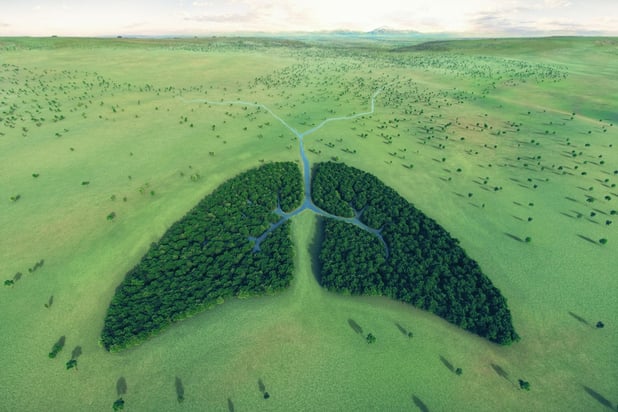

The average global surface temperature in 2021 was the sixth highest since global records began in 1880 and the 45th consecutive year with temperatures, at least nominally, above the 20th century average, according to the US National Oceanic and Atmospheric Administration (NOAA) Global Climate Report – Annual 2021.
North America experienced its seventh warmest year on record in 2021, with a temperature that was 1.40°C (2.52°F) above average, according to the NOAA. This marks North America’s 25th consecutive year with temperatures, at least nominally, above average.
As detailed in the NOAA Global Climate Report - Annual 2021, the year began with temperatures that were above average across much of northern North America, but this was quickly followed by a strong negative Arctic Oscillation in February that allowed cold Arctic air to reach to the mid-latitudes, causing temperatures to fall below average.
The months of March, and June through October, ranked among North America’s top 10 warmest for each respective month, with June 2021 being the warmest June on record. This came to a head at the end of the month when an extreme heat wave hit the northwestern contiguous US and western Canada.
In Lytton, British Columbia, the temperature recorded on June 29, 2021, was 49.6°C (121.3°F), which was a new national maximum temperature record – and the intense heat was blamed for close to 800 reported deaths and hospitalizations across the region.
Under the Paris Agreement, a legally binding international treaty on climate change, the goal is to keep the rise in average global temperature to well below 2°C (3.6°F) above pre-industrial levels, and preferably limit the increase to 1.5°C (2.7°F). To achieve that goal, global C02 emissions need to be cut by roughly 50% by 2030.
However, reducing emissions to that scale is easier said than done, according to Chris Gottardo, head of global business development, financial institutions, climate change solutions, at Munich Re. Speaking at CatIQ Connect, he shared some “pretty scary numbers” which show that the probability of the world achieving the Paris Agreement’s 2°C (3.6°F) global warming is the same as the world recording 5°C global warming.
“At the moment, the highest probability is that we’re likely to be in a 4°C to 6°C pathway [by 2030] – and you can imagine what that might be like if that turns out to be true,” said the Munich Re leader. “We’re not going to get there. If we think about the current pledges, we are not going to get under 2%. We’re not going to get anywhere near 1.5%. It’s more like 4%.”
One way of looking at this is that the world needs to drastically reduce the amounts of manmade emissions, predominately in the energy sector. As Gottardo pointed out, there has been lots of pressure in recent years from various net zero alliances and NGO communities to expedite the phase out of fossil fuels.
“We like to think of it in a slightly different way,” he said, referring to some of the public statements that Munich Re CEO Joachim Wenning made at COP26, and the global reinsurer’s publicly accessible Climate Ambition 2025. “It’s about looking at negative emissions. It’s about a massive investment in the removal, through various technologies, of C02 from the atmosphere.
“Now, some of the technology doesn’t exist yet, or it’s very early stage, but thinking about not just the risks that we’re trying to avoid here, but what are the new business opportunities as we look at new technologies to try to tackle this huge issue that we’ve got in front of us?”
There are multiple business risks associated with climate change and how companies respond to it. First and foremost, there are the physical risks that present significant property exposures.
Gottardo explained that even a small change in temperature can make a significant difference to natural hazard risk, triggering events like extreme rainfall, more intense hailstorms, increased tornado risk, and wildfires – all of which have been seen in greater frequency and severity across North America in recent years.
“As for hurricane risk, with the warmer temperatures in the sea, that increases the intensity of a hurricane. It pushes them further inland, it gives them more strength, so that they’re going to be sitting overland for longer periods of time - and the amount of risk and flood damage associated with that will also increase,” said Gottardo. “There are some studies to say that while they will become more intense, they may become less frequent.
“Sea level rise is obviously an issue, coastal erosion, and combine that with storm surge - that’s also a significant risk. And obviously you’ve got your ice melt-related risks in your part of the world. So, quite a number of natural disasters are likely to increase through the increase in the temperature of the Earth.”
Beyond the physical risks associated with extreme climate-related events, Gottardo also highlighted transitional risks and liability risks during his keynote speech at CatIQ Connect.
He said it’s important to consider the reporting and disclosure of risks within an organization, adding: “Transitional risk is obviously very important as well. That’s the risk of a stranded asset. If there’s a shift from an asset that may have been used in the old carbon-intensive economy [and it] gets left behind [and] its useful life is curtailed, there’s a transition risk there.
“Liability risk is one that’s often understated - one that at Munich Re we’re spending a lot of time on gathering information on. This will be the risk that will come and hurt some people sometime soon. It is the risk related to legal claims against climate-related activity or failing to do something and someone attributing a particular event to your lack of action.”
